The Nested Topological Band-Gap Structure for the Periodic Domain Walls in a Photonic Super-Lattice
Abstract
:1. Introduction
2. Model of 1D Super-Lattice
3. Results and Analyses
3.1. Disappearance of the Original DW and the New Band-Gap Structure of the Photonic Super-Lattice
3.2. Theory of Coupled DWs in the Photonic Super-Lattice Model
3.3. Topological Interface State between Two Photonic Super-Lattices
3.4. The Nested Topological Band-Gap Structure in a 2D Photonic Super-Lattice
4. Conclusions
Author Contributions
Funding
Data Availability Statement
Conflicts of Interest
References
- Bianchi, N.J.; Kahn, L.M. Optical states in a 1D superlattice with multiple photonic crystal interfaces. J. Opt. 2020, 22, 065101. [Google Scholar] [CrossRef]
- Yablonovitch, E. Inhibited spontaneous emission in solid-state physics and electronics. Phys. Rev. Lett. 1987, 58, 2059. [Google Scholar] [CrossRef] [PubMed]
- Lu, L.; Joannopoulos, J.D.; Soljačić, M. Topological photonics. Nat. Photonics 2014, 8, 821–829. [Google Scholar] [CrossRef]
- Amnon, Y.; Yeh, P. Optical Waves in Crystals: Propagation and Control of Laser Radiation; Wiley: New York City, NY, USA, 1984. [Google Scholar]
- Ma, G.; Xiao, M.; Chan, C.T. Topological phases in acoustic and mechanical systems. Nat. Rev. Phys. 2019, 1, 281–294. [Google Scholar] [CrossRef]
- Ling, C.; Xiao, M.; Chan, C.T.; Yu, S.F.; Fung, K.H. Topological edge plasmon modes between diatomic chains of plasmonic nanoparticles. Opt. Express 2015, 23, 2021–2031. [Google Scholar] [CrossRef]
- Gao, W.; Hu, X.; Li, C.; Yang, J.; Chai, Z.; Xie, J.; Gong, Q. Fano-resonance in one-dimensional topological photonic crystal heterostructure. Opt. Express 2018, 26, 8634–8644. [Google Scholar] [CrossRef]
- Peng, Y.; Xu, J.; Dong, H.; Dai, X.; Jiang, J.; Qian, S.; Jiang, L. Graphene-based low-threshold and tunable optical bistability in one-dimensional photonic crystal Fano resonance heterostructure at optical communication band. Opt. Express 2020, 28, 34948–34959. [Google Scholar] [CrossRef]
- Wu, L.H.; Hu, X. Scheme for achieving a topological photonic crystal by using dielectric material. Phys. Rev. Lett. 2015, 114, 223901. [Google Scholar] [CrossRef]
- Guo, J.; Wang, H.; Dai, X.; Xiang, Y.; Tang, D. Enhanced nonlinear optical responses of graphene in multi-frequency topological edge modes. Opt. Express 2019, 27, 32746–32763. [Google Scholar] [CrossRef]
- Dueñas, J.M.; Pérez, G.O.; Hermann-Avigliano, C.; Torres, L.E.F. Quadrature protection of squeezed states in a one-dimensional photonic topological insulator. Quantum 2021, 5, 526. [Google Scholar] [CrossRef]
- Li, E.; Eggleton, B.J.; Fang, K.; Fan, S. Photonic Aharonov–Bohm effect in photon–phonon interactions. Nat. Commun. 2014, 5, 3225. [Google Scholar] [CrossRef]
- Liu, C.; Ong, H. Realization of topological superlattices and the associated interface states in one-dimensional plasmonic crystals. Phys. Rev. B 2022, 106, 045401. [Google Scholar] [CrossRef]
- Xiao, Y.X.; Ma, G.; Zhang, Z.Q.; Chan, C.T. Topological subspace-induced bound state in the continuum. Phys. Rev. Lett. 2017, 118, 166803. [Google Scholar] [CrossRef] [PubMed]
- Cheng, X.; Jouvaud, C.; Ni, X.; Mousavi, S.H.; Genack, A.Z.; Khanikaev, A.B. Robust reconfigurable electromagnetic pathways within a photonic topological insulator. Nat. Mater. 2016, 15, 542–548. [Google Scholar] [CrossRef] [PubMed]
- Hafezi, M.; Mittal, S.; Fan, J.; Migdall, A.; Taylor, J. Imaging topological edge states in silicon photonics. Nat. Photonics 2013, 7, 1001–1005. [Google Scholar] [CrossRef]
- Peng, Y.G.; Geng, Z.G.; Zhu, X.F. Topologically protected bound states in one-dimensional Floquet acoustic waveguide systems. J. Appl. Phys. 2018, 123, 091716. [Google Scholar] [CrossRef]
- Liu, J.; Fu, L. Berry phase in nonlinear systems. Phys. Rev. A 2010, 81, 052112. [Google Scholar] [CrossRef]
- Elsayed, H.A.; Taha, T.; Algarni, S.A.; Ahmed, A.M.; Mehaney, A. Evolution of optical Tamm states in a 1D photonic crystal comprising a nanocomposite layer for optical filtering and reflecting purposes. Opt. Quantum Electron. 2022, 54, 312. [Google Scholar] [CrossRef]
- Elsayed, H.A. Transmittance properties of one dimensional ternary nanocomposite photonic crystals. Mater. Res. Express 2018, 5, 036209. [Google Scholar] [CrossRef]
- Wang, T.B.; Yin, C.P.; Liang, W.Y.; Dong, J.W.; Wang, H.Z. Electromagnetic surface modes in one-dimensional photonic crystals with dispersive metamaterials. JOSA B 2009, 26, 1635–1640. [Google Scholar] [CrossRef]
- Wang, X.; Liang, Y.; Wu, L.; Guo, J.; Dai, X.; Xiang, Y. Multi-channel perfect absorber based on a one-dimensional topological photonic crystal heterostructure with graphene. Opt. Lett. 2018, 43, 4256–4259. [Google Scholar] [CrossRef]
- Blanco-Redondo, A.; Andonegui, I.; Collins, M.J.; Harari, G.; Lumer, Y.; Rechtsman, M.C.; Eggleton, B.J.; Segev, M. Topological optical waveguiding in silicon and the transition between topological and trivial defect states. Phys. Rev. Lett. 2016, 116, 163901. [Google Scholar] [CrossRef]
- Xiao, M.; Zhang, Z.; Chan, C.T. Surface impedance and bulk band geometric phases in one-dimensional systems. Phys. Rev. X 2014, 4, 021017. [Google Scholar] [CrossRef]
- Xiao, M.; Ma, G.; Yang, Z.; Sheng, P.; Zhang, Z.; Chan, C.T. Geometric phase and band inversion in periodic acoustic systems. Nat. Phys. 2015, 11, 240–244. [Google Scholar] [CrossRef]
- Wang, F.; Song, X.Y.; Chio, U.; Wang, W.; Tang, X.H. Angular-adjustable single-channel narrow-band filter based on one-dimensional photonic crystal heterostructure. AIP Adv. 2021, 11, 095013. [Google Scholar] [CrossRef]
- Su, W.P.; Schrieffer, J.R.; Heeger, A.J. Solitons in polyacetylene. Phys. Rev. Lett. 1979, 42, 1698. [Google Scholar] [CrossRef]
- Asbóth, J.K.; Oroszlány, L.; Pályi, A. A short course on topological insulators. Lect. Notes Phys. 2016, 919, 166. [Google Scholar]
- Munoz, F.; Pinilla, F.; Mella, J.; Molina, M.I. Topological properties of a bipartite lattice of domain wall states. Sci. Rep. 2018, 8, 17330. [Google Scholar] [CrossRef]
- Liu, Y.; Xiong, L.; Jiang, X. The evolution of topological singularities between real-and complex-frequency domains and the engineering of photonic bands for Hermitian and non-Hermitian photonic crystals. New J. Phys. 2023, 24, 123042. [Google Scholar] [CrossRef]
- Xiong, L.; Zhang, Y.; Jiang, X. Resonance and topological singularity near and beyond zero frequency for waves: Model, theory, and effects. Photonics Res. 2021, 9, 2024–2036. [Google Scholar] [CrossRef]
- Wei, T.; Wang, Y. Coupled topological edge states in one-dimensional all-dielectric heterostructures. Opt. Express 2022, 30, 36900–36911. [Google Scholar] [CrossRef] [PubMed]
- Schmidt, C.; Palatnik, A.; Sudzius, M.; Meister, S.; Leo, K. Coupled topological interface states. Phys. Rev. B 2021, 103, 085412. [Google Scholar] [CrossRef]
- Markos, P.; Soukoulis, C.M. Wave Propagation: From Electrons to Photonic Crystals and Left-Handed Materials; Princeton University Press: Princeton, NJ, USA, 2008. [Google Scholar]
- Zhan, T.; Shi, X.; Dai, Y.; Liu, X.; Zi, J. Transfer matrix method for optics in graphene layers. J. Phys. Condensed Matter 2013, 25, 215301. [Google Scholar] [CrossRef] [PubMed]
- Wang, H.X.; Guo, G.Y.; Jiang, J.H. Band topology in classical waves: Wilson-loop approach to topological numbers and fragile topology. New J. Phys. 2019, 21, 093029. [Google Scholar] [CrossRef]
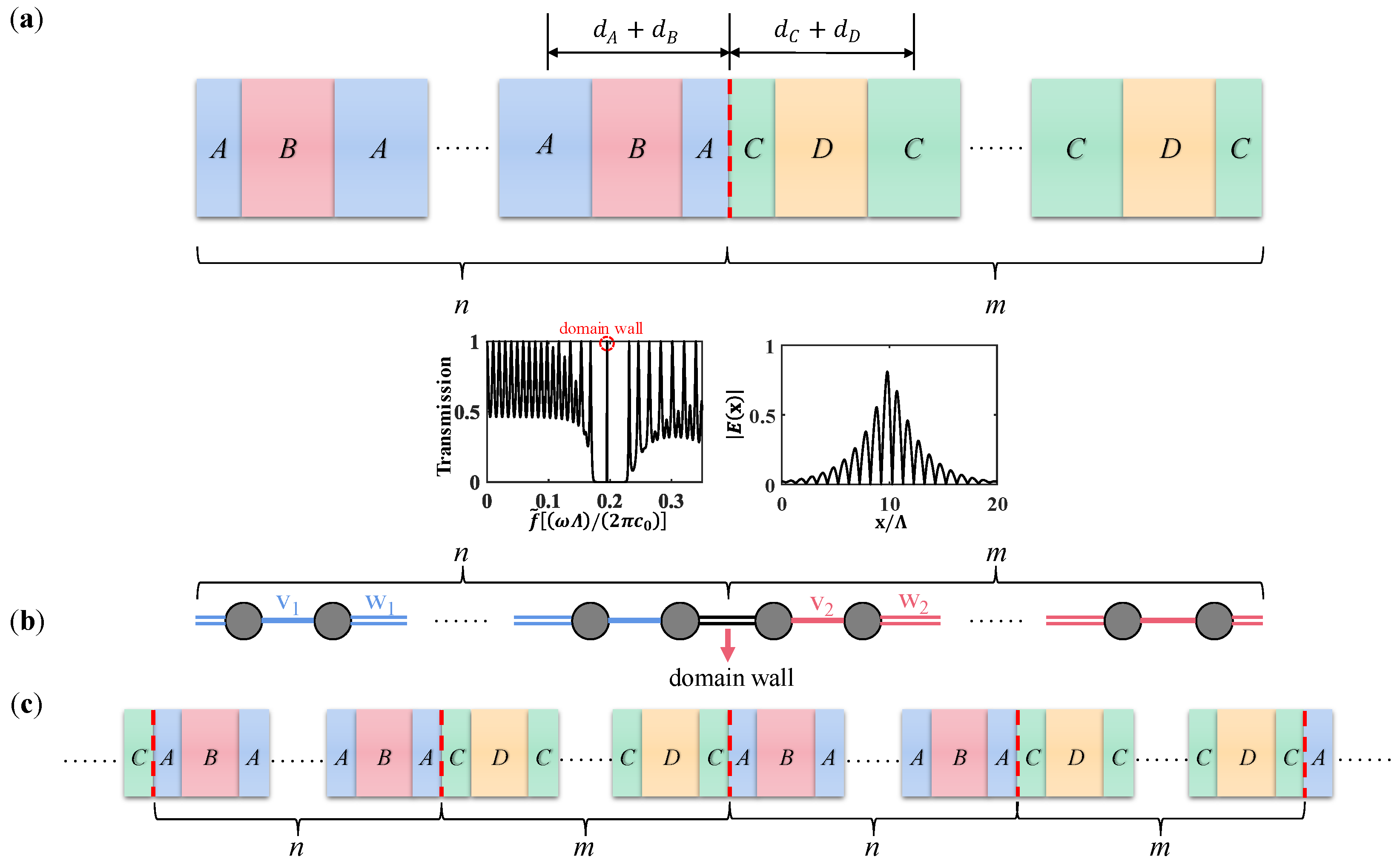
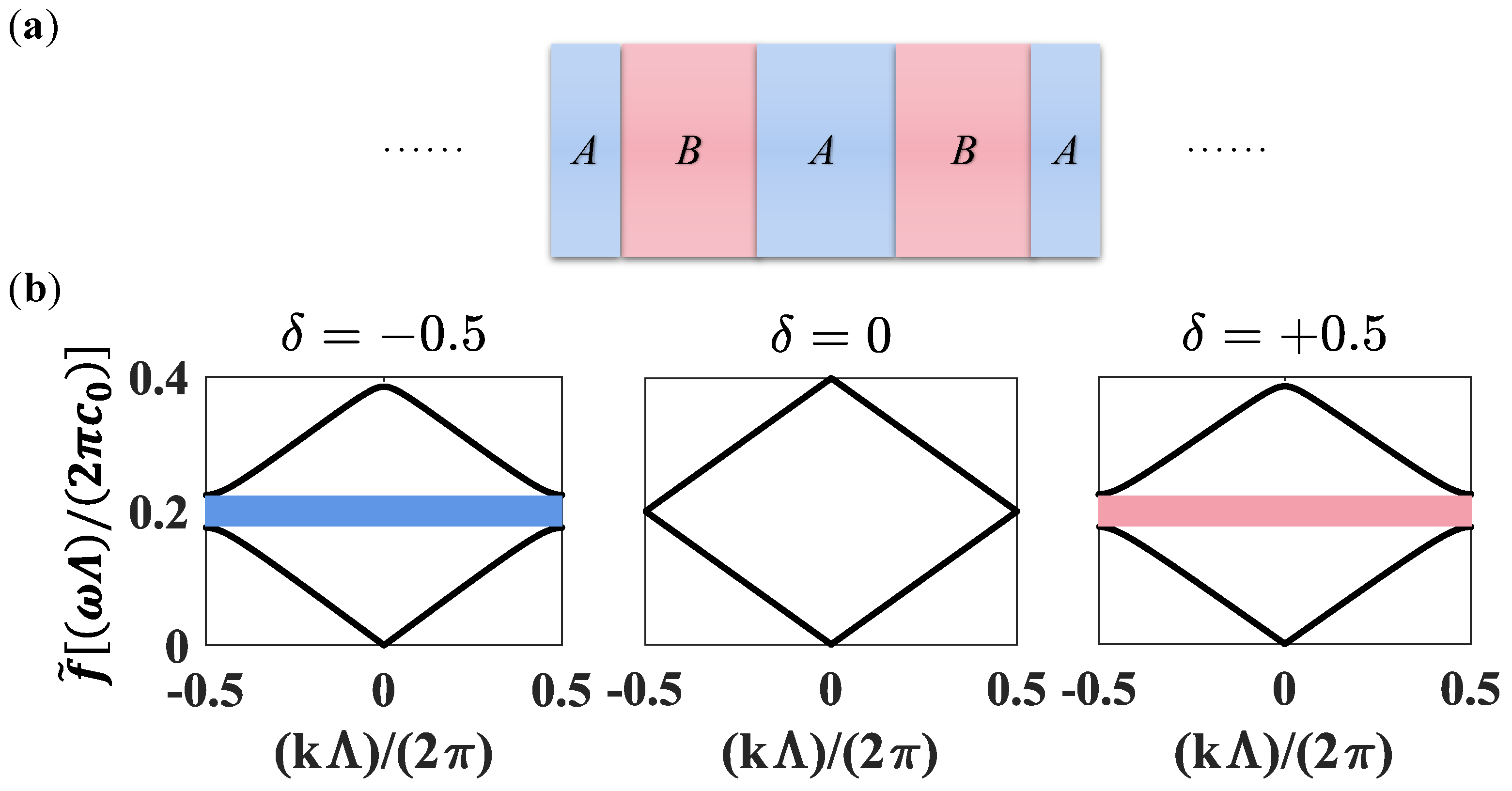


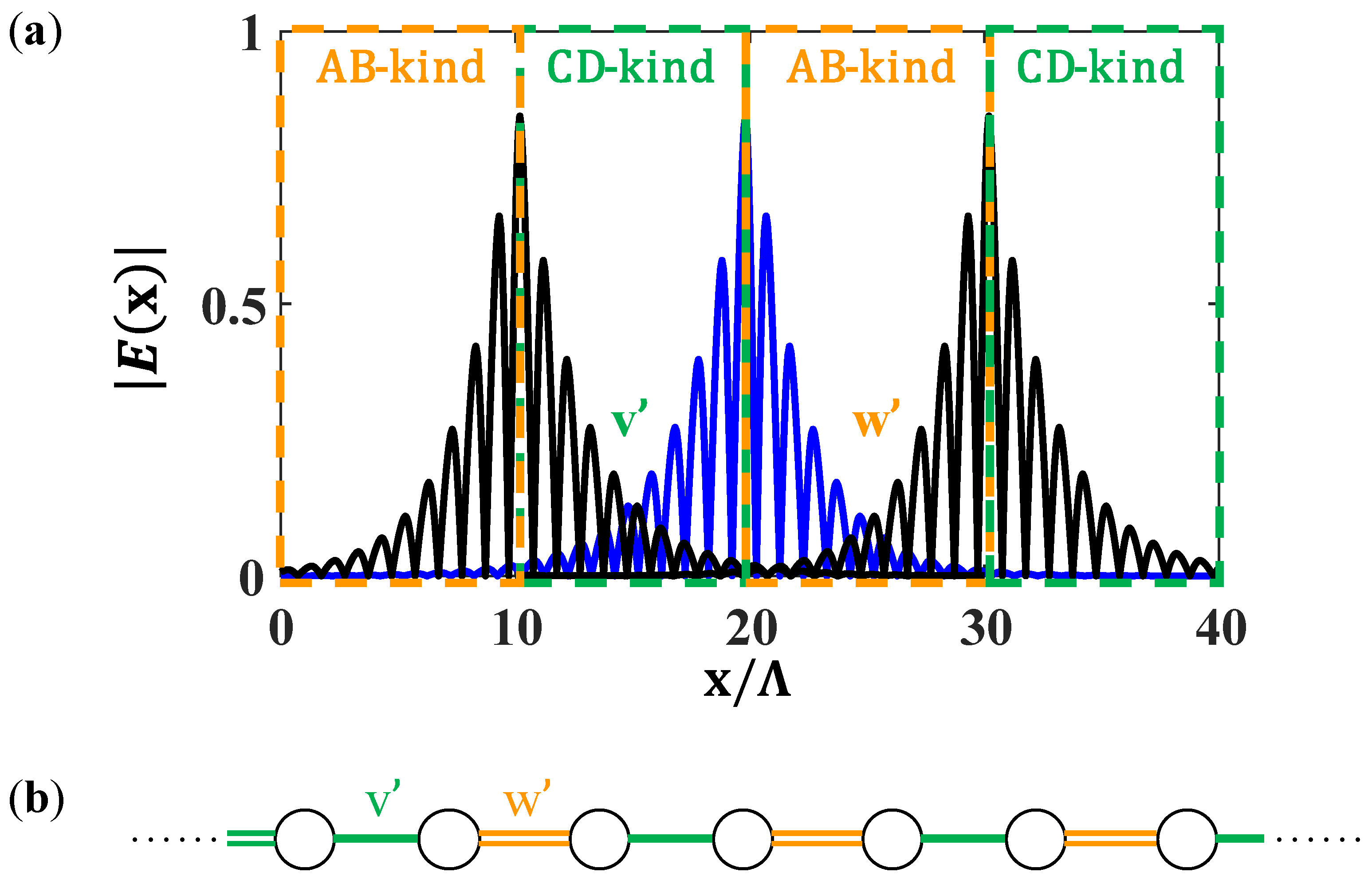
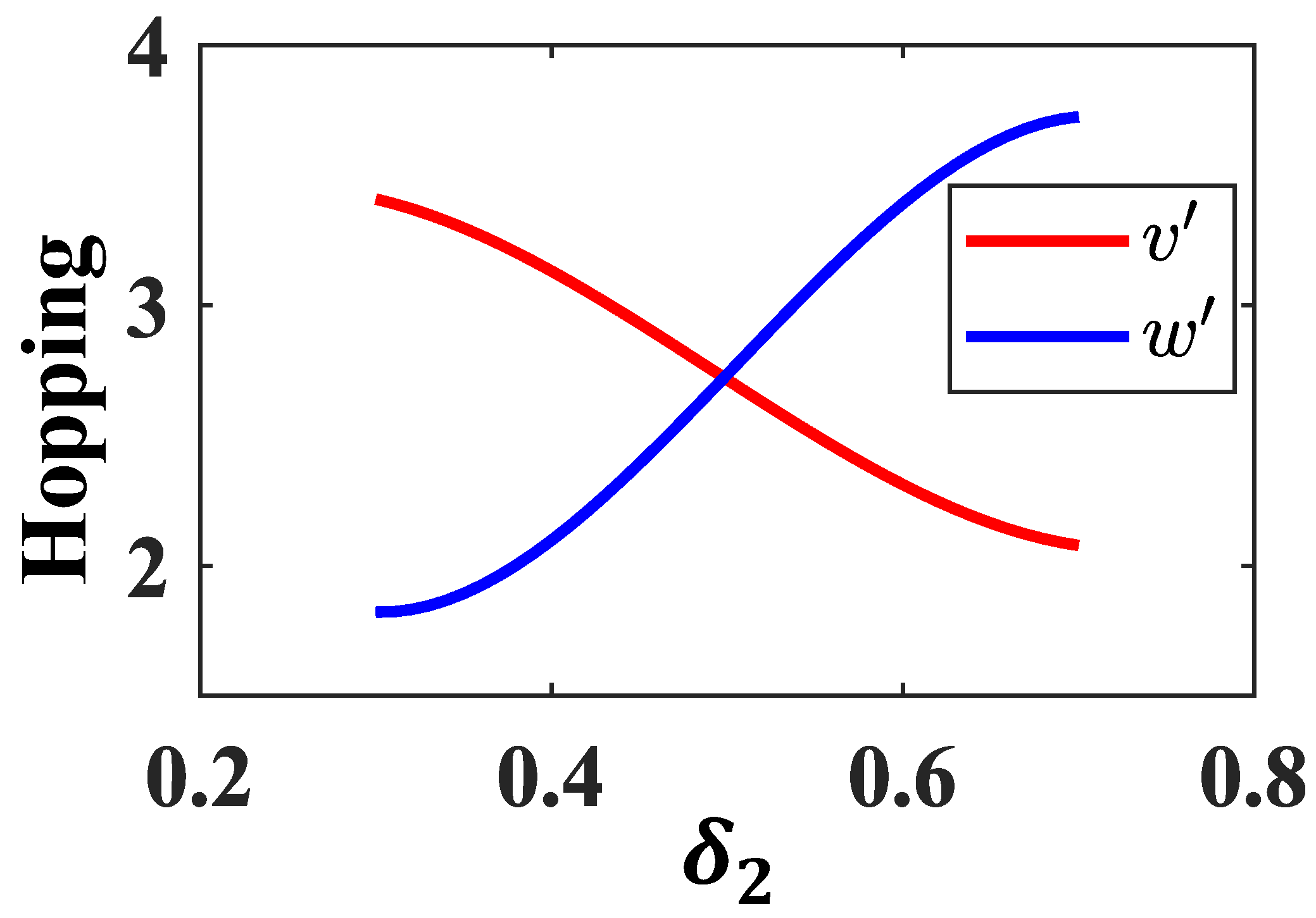
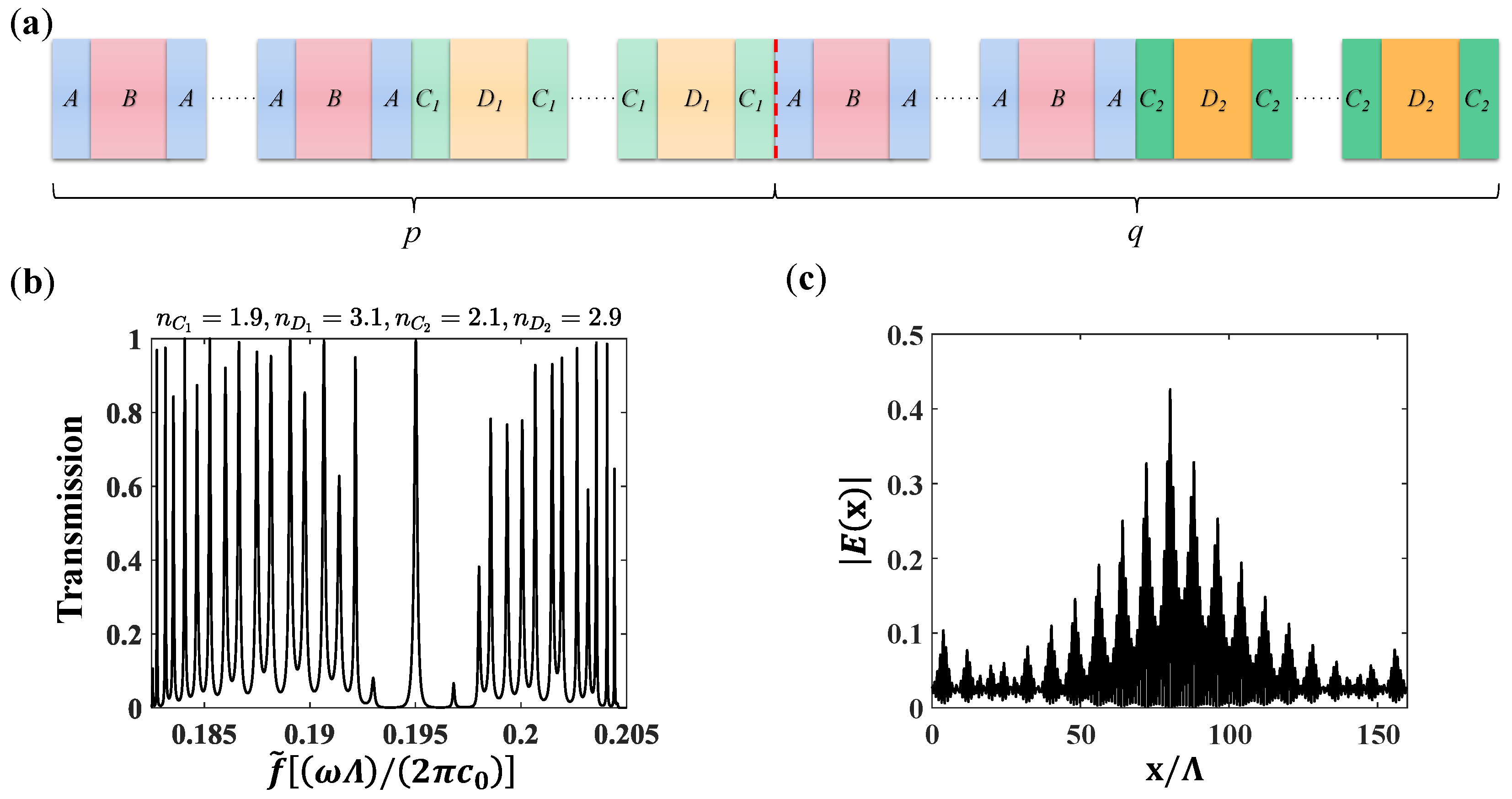
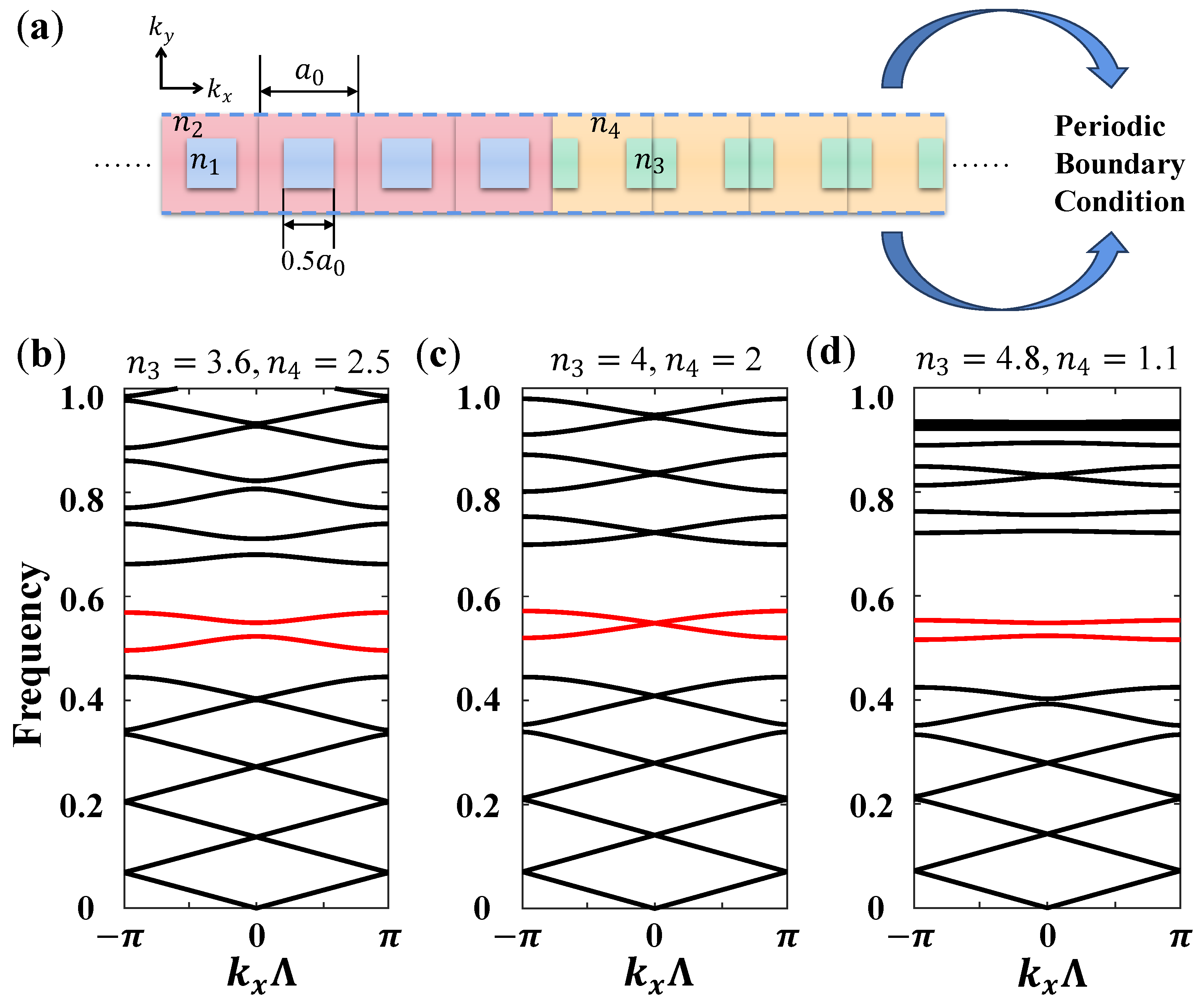

Disclaimer/Publisher’s Note: The statements, opinions and data contained in all publications are solely those of the individual author(s) and contributor(s) and not of MDPI and/or the editor(s). MDPI and/or the editor(s) disclaim responsibility for any injury to people or property resulting from any ideas, methods, instructions or products referred to in the content. |
© 2024 by the authors. Licensee MDPI, Basel, Switzerland. This article is an open access article distributed under the terms and conditions of the Creative Commons Attribution (CC BY) license (https://creativecommons.org/licenses/by/4.0/).
Share and Cite
Lai, Z.; Liu, Y.; Li, Y.; Wang, X.; Jiang, X. The Nested Topological Band-Gap Structure for the Periodic Domain Walls in a Photonic Super-Lattice. Crystals 2024, 14, 757. https://doi.org/10.3390/cryst14090757
Lai Z, Liu Y, Li Y, Wang X, Jiang X. The Nested Topological Band-Gap Structure for the Periodic Domain Walls in a Photonic Super-Lattice. Crystals. 2024; 14(9):757. https://doi.org/10.3390/cryst14090757
Chicago/Turabian StyleLai, Zhen, Yufu Liu, Yunlin Li, Xuezhi Wang, and Xunya Jiang. 2024. "The Nested Topological Band-Gap Structure for the Periodic Domain Walls in a Photonic Super-Lattice" Crystals 14, no. 9: 757. https://doi.org/10.3390/cryst14090757




